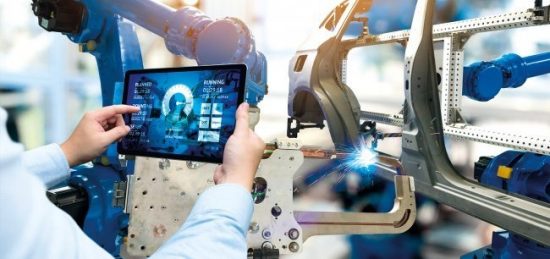How To Increase Energy Efficiency With Machine Tools
Machine tools include numerous motors and auxiliary components. Energy consumption varies significantly during operations. From the process itself to individual component power consumption, savings potential can be evaluated and measures defined for more efficient energy use. Article by Grainger.
One area of potential savings comes from the machine tool base load, which consumes energy even in nonproductive phases. The base load is determined substantially by the machine’s auxiliary components. Besides use of energy-efficient motors in these components, many opportunities for reducing the base load can be found. Some energy consumers, for example, can be switched off by the machine control during non-productive phases.
Scrap inevitably increases energy consumption per good part. Manufacturing with accuracy from the very first part can therefore be decisive for energy efficiency. Machine designs with balanced thermal behaviour and precise position measuring technology have a distinct advantage here.
Energy Demand During Milling
Power requirements of a milling process fall into the following consumer groups:
- Cooling lubricant processing
- Compressed air generation
- Electrically powered milling-machine auxiliary components
- CNC control package with main spindle and feed-axis motors
Proportionally calculated energy for lighting, ventilation, and air conditioning must be added to these groups. Milling process energy demand depends primarily on the size of the milling machine and the machining task.
Dry machining has great potential for improved energy and resource efficiency. In many milling applications, however, doing without cooling lubricant increases scrap rate and, therefore, raises mean energy consumption as well.
Compressed air is required for minimum spindle lubrication, tool changing, and work piece cleaning. Small quantities are required as sealing air. Mean compressed air power changes only slightly across production readiness, roughing, and finishing.
Machine electricity consumers include the CNC control with main spindle and feed-axis motors, as well as numerous auxiliary components, including the pallet changer and cooling, hydraulics and automation systems.
Drive Component Efficiency
Spindle and feed-axis motors are among the central components of a machine tool. Drive-component energy efficiency depends on the ratio of delivered power to consumed power. The network of drives converts consumed electrical energy to delivered mechanical power. Drive network components include a power supply module, drive modules, motors and mechanical components. Data on efficiency typically refer to the rated power. For other rated values, individual component efficiency can vary significantly. Supply modules and drive modules can attain efficiency values of more than 95 percent.
Comparing power consumption during rough-face and circular-pocket milling reveals that feed drives consume only a small share of the CNC’s total power usage. On the other hand, spindle selection can significantly affect energy consumption. If a spindle drive operates far below its rated power, the drive’s intrinsic losses increase in proportion, with negative effects on the energy balance. If the spindle limits the maximum possible metal removal rate, the milling process inevitably takes longer. The result: energy efficiency decreases due to the base load generated by the auxiliary components. Potential also exists for more efficient design of milling processes through consideration of spindle-motor efficiency, for example by using synchronous instead of asynchronous motors.
Regenerative Supply Modules
Every drive’s acceleration requires a braking process in return. Energy from the drives’ moving masses is largely reconverted to electrical energy. In a non-regenerative supply module, kinetic energy released by braking is converted to heat by the braking resistors. A regenerative supply module returns this energy to the power grid. However, the path required for returning the energy and the necessary components for smoothing the grid power generate losses even when the drives have no power requirement. Power loss increases slightly even when power is not being regenerated. Thus, a regenerative supply module operates more efficiently than a non-regenerative module when the regenerated energy more than compensates the higher power loss. Machine operation therefore determines what type supply module to employ.
Tool change frequency also impacts this decision. In one example, a milling operation at 15 kW is interrupted cyclically by a tool change. Starting the spindle requires peak power of approximately 60 kW. A regenerative supply module returns 48 kW to grid power. High metal-cutting power requirements mean that the mean-input power sinks the more frequently the milling process is interrupted by tool changes.
A regenerative supply module works more efficiently as soon as the time interval between two tool changes is less than 100 seconds (equals 0.6 tool changes per minute). In processes with many tool changes per minute, a regenerative supply module often proves to be the better choice. During contour milling with infrequent tool changes, the advantages are on the side of the non-regenerative system.
Deactivation Of Auxiliary Components
In the ready condition, energy use of several consumer groups is only slightly reduced. Therefore, these nonproductive phases must be kept as brief as possible. With machining centres for smaller production batches, energy consumption can be significantly reduced by the selective deactivation of auxiliary components. Beyond this, potential savings result from the use of energy efficient pumps in the coolant and lubricant circuit.
However, consistent switch-off of auxiliary components – such as hydraulics and spindle cooling – or of the compressed-air supply can also have a deleterious effect. If sudden removal of waste heat from auxiliary components, or of temperature-stabilising media, leads to thermal displacement in the machine frame, scrap can result. Selective auxiliary component switch-off therefore functions best on machines with little inclination to thermal displacement.
CNCs can be the central control unit for machine tool energy management, taking advantage of special PLC functions for linking events in the production process (such as NC stop) with outputs for controlling auxiliary components. Delay times can be assigned to events so that, for example, motors can be locked and disconnected from current after standstill. Functions for deactivating various auxiliary devices, axes, light in the working space, etc., can be generated on this basis. These basic functions are the responsibility of the machine tool builder. For users, it is helpful to adapt energy management to specific usage habits.
WANT MORE INSIDER NEWS? SUBSCRIBE TO OUR DIGITAL MAGAZINE NOW!
CHECK OUT OUR LATEST ISSUE!
FOLLOW US ON: LinkedIn, Facebook, Twitter













